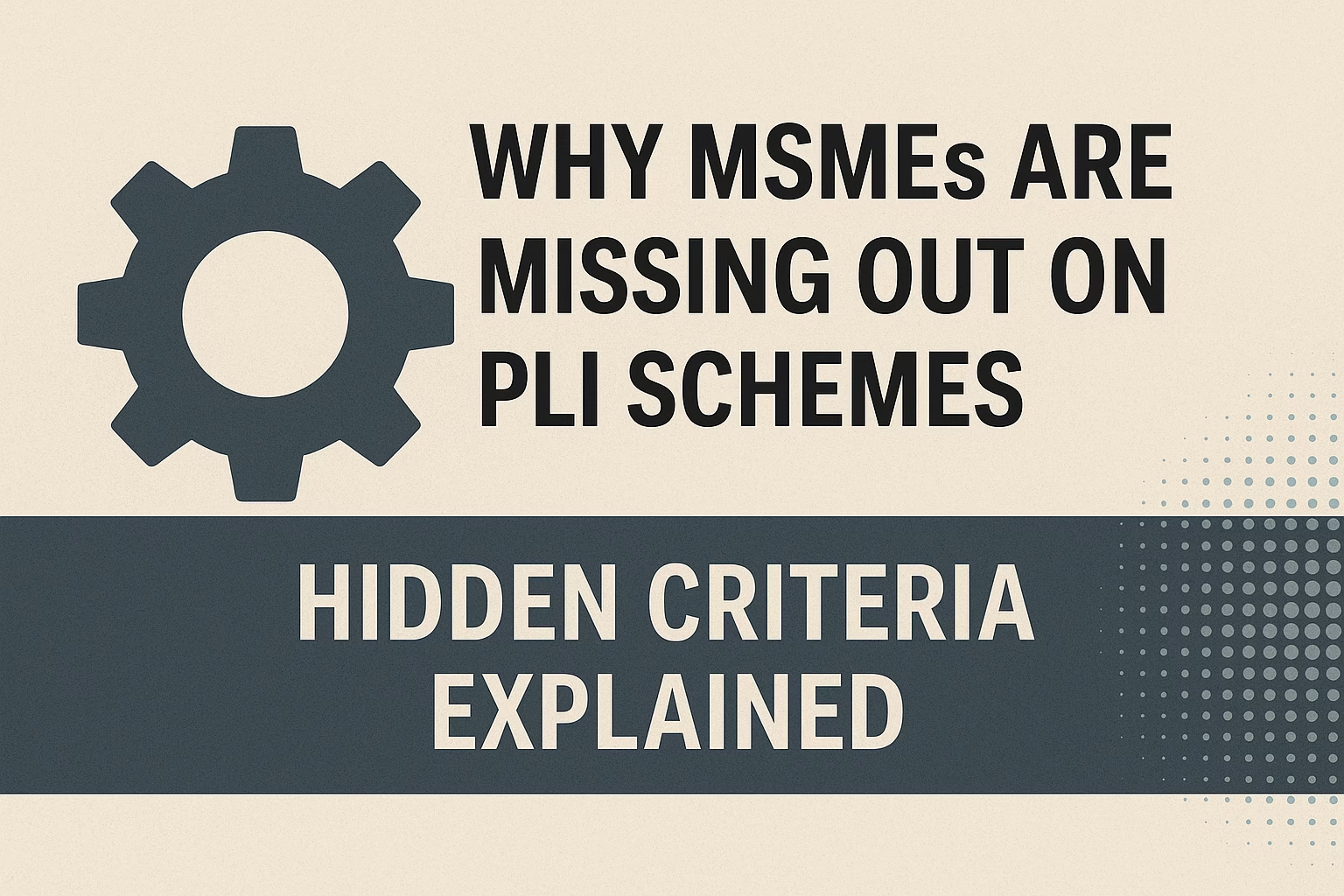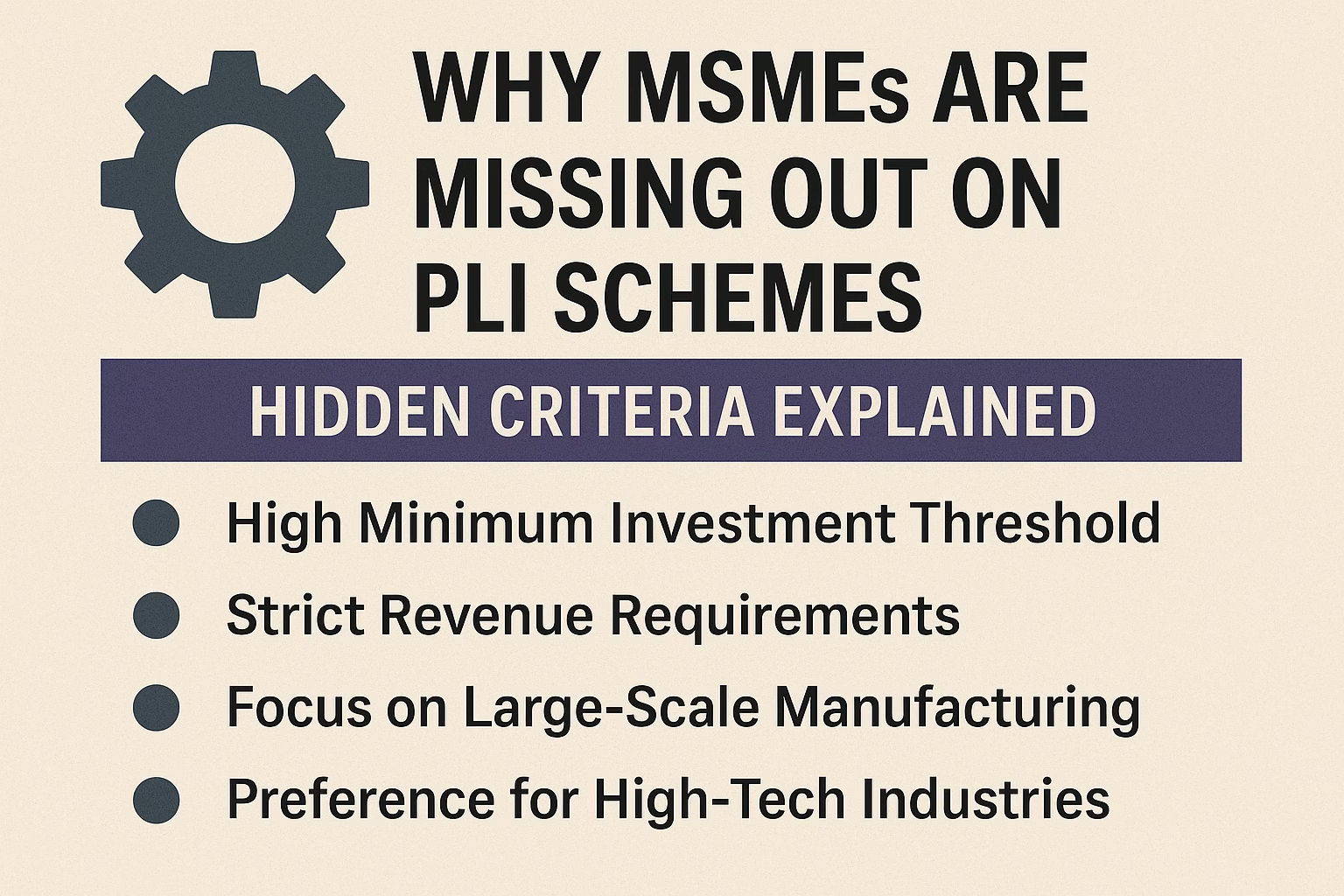Table of Contents
Introduction: MSMEs Missing Out on PLI Schemes
The Indian government’s Production Linked Incentive (PLI) programs were started with a big goal: to make India a global manufacturing hub as part of the “Atmanirbhar Bharat” initiative. The plan promised a golden age for manufacturers by giving ₹3 lakh crore to 14 different sectors. But there’s a problem: MSMEs (Micro, Small, and Medium Enterprises), which are the backbone of India’s economy, aren’t getting much of it.

Why? It’s not just that people don’t know. There are hidden criteria and systemic barriers that make it impossible for MSMEs to get in. This article explains why this is happening, what the problems are, and what can be done to fix them.
A Quick Overview of the PLI Scheme
The PLI program gives manufacturers monetary incentives based on how much more they sell or make than they did in a base year. It includes fields like electronics, pharmaceuticals, cars, textiles, and solar panels.
**Goal:
- Bring in investment from around the world. * Increase production at home * Create jobs. Depend less on imports
Sounds great, doesn’t it? But here’s the twist—
“Why MSMEs Missing Out On PLI Schemes: Hidden Criteria Unveiled”
1.High Minimum Investment and Turnover Limits
Most PLI programs need:
- Minimum investment of ₹100 crore+ * Turnover of ₹250 crore+ * Ability to produce on a global scale
These limits are completely unrealistic for a typical Indian MSME that makes less than ₹50 crore a year.
“The plan talks about including everyone, but it only sets goals that big companies can reach.” — Rajeev Jain, who owns a medium-sized auto parts store in Haryana
2. Guidelines that are not clear
Most of the time, PLI schemes come with
- Hard-to-understand eligibility rules
- Technical standards that only apply to certain sectors
- Different types of paperwork
MSMEs lack the financial and legal expertise necessary to decipher these.
3. There is a skewed sectoral focus toward major players.
PLI gives priority to:
- Low labor-intensive sectors, disregarding traditional MSME strongholds like handicrafts, food processing, and clothing;
- High-tech and capital-intensive sectors, such as electronics, EVs, and telecom
MSMEs are indirectly filtered out by this sectoral bias.
4. Delayed Incentive Payouts
Funds are only released after performance validation and multi-stage audits, even in cases that have been approved. Small businesses that are already struggling with cash flow cannot afford to wait.
5. Difficult Application Procedure
Applying for PLI entails:
- Monthly performance reporting
- Various approval levels
- Intricate audits and documentation
A small business with ten to fifteen workers just does not have the bandwidth for this kind of red tape.

The Silent Struggle of India’s Small Businesses
It’s not just data—it’s personal. When we talk about MSMEs missing out on PLI schemes, we’re talking about families, dreams, and generations of hard work slowly being left behind. Across India, thousands of small manufacturers are investing their sweat and savings, hoping to be part of the country’s growth story. But the reality is harsh: MSMEs missing out on PLI schemes feel a growing sense of exclusion, as if policy success is measured only by big-ticket investments and billion-dollar turnovers. While the headlines celebrate conglomerates reaping massive subsidies, MSMEs missing out on PLI schemes remain in the shadows, often unaware or unable to qualify despite their capabilities.
Ask any small-scale unit owner in Bhiwadi, Ludhiana, or Coimbatore—they’ll tell you it’s not about unwillingness; it’s about access. MSMEs missing out on PLI schemes feel like they’re navigating a game designed for giants, with rules and rewards they can’t even understand, let alone reach. As India pushes toward becoming a global manufacturing hub, the nation must pause and reflect—can we really afford to keep MSMEs missing out on PLI schemes outside the gate of progress?
Practical Effect on MSMEs
- MSMEs have cornered less than 3% of the ₹2 lakh crore sanctioned so far. * In electronics manufacturing alone, 95% of beneficiaries are large companies like Foxconn, Wistron, and Dixon.
- Textile MSMEs have expressed concerns about being passed over in favor of big conglomerates, particularly in Tamil Nadu and Gujarat.
** “PLI is now a club for big boys.” We have no place at the table. **> — *Shilpa Desai, owner of a textile MSME in Surat*
Is This By Default or By Design?
Although MSMEs are not specifically excluded, many experts contend that the scheme’s design inherently disadvantages them. Among the critiques are
- Top-down policy making without consultation at the grassroots level
- Copy-pasting of Western industrial models unsuitable for Indian SMEs.
- No transitional support or capacity-building for MSMEs**
“MSME Loan Rejection in India: Real Reasons and a Step-by-Step Fix for 2025”
How Can This Be Fixed?
✅ Establish MSME-Centered PLI Sub-Schemes
- Sector-specific incentives for traditional industries * Simplified documentation * Lower investment thresholds (₹10–50 crore)
✅ Help for Building Capacity
- Online helpdesks for documentation and compliance * Government-backed consultants for application support * Training initiatives through MSME Development Institutes
✅ Easier Method of Payment
- Part of the funds are released immediately upon commitment of investment. Grievances handled through a single window
✅ Update Sectoral Priorities
- Incorporate labor-intensive MSME sectors such as food processing, ceramics, and toy manufacturing.
- Promote cluster-based development by making groups eligible for PLI.
Government’s Response So Far
The gap has been recognized by the Ministry of Commerce and Industry. Lately, there have been conversations about:
PLI 2.0″ for MSMEs
- * Sector-specific PLI with simpler requirements (e.g., PLI for Toys in the 2024 budget)
- * New initiatives under ‘Make in India 2.0’ that could better accommodate the needs of MSMEs
However, there hasn’t been a full rollout yet, and these are still in the planning stage.
Final Thought: Rethinking “Incentive for All”
Nearly 30% of India’s GDP is contributed by MSMEs, which employ more than 11 crore Indians. In addition to being unfair, ignoring them in flagship programs like PLI is economically unsustainable.
India must empower its smallest units as much as its largest if it is to be a global manufacturing powerhouse.
“Atmanirbhar Bharat cannot be established solely on the backs of corporations.” MSMEs must be its lifeblood.
Economic Times, Policy Analyst
Best Side Business Ideas for Housewives in India – 2025
Call to Action
Are you an MSME owner who finds it difficult to take advantage of government programs?
Share this article to spread awareness. 👉
Tag @msmeind on X (Twitter). 👉
Tell us your story in the comments 👉

[…] Why MSMEs Missing Out on PLI Schemes—Hidden Criteria Explained 2025 […]